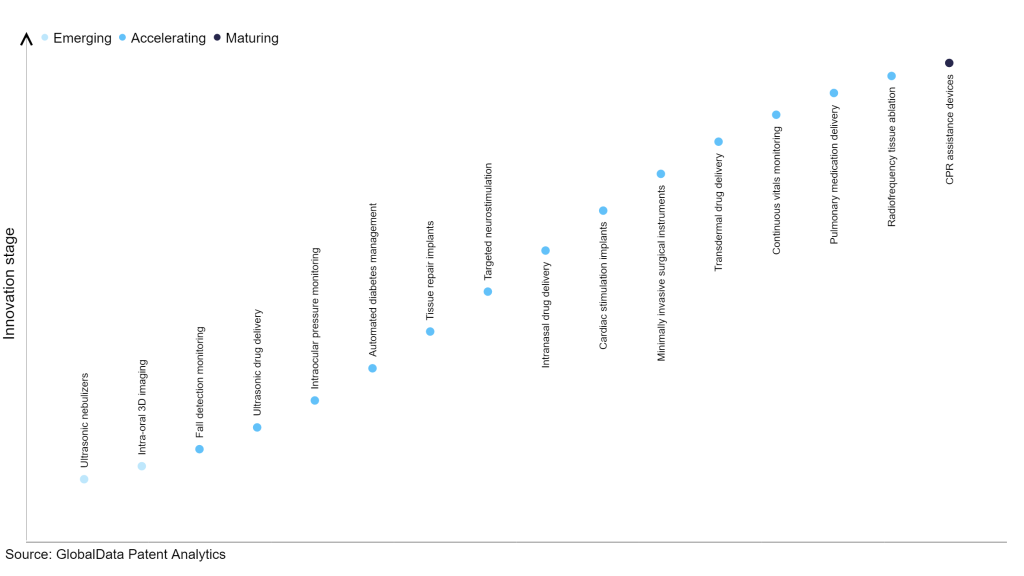The medical devices industry continues to be a hotbed of patent innovation. Activity is driven by increased need for homecare, preventative treatments, early diagnosis, reducing patient recovery times and improving outcomes, and growing importance of technologies such as machine learning, augmented reality, 5G and Digitalization. In the last three years alone, there have been over 710,000 patents filed and granted in the medical devices industry, according to GlobalData’s report on Innovation in medical: intraocular pressure monitoring. Buy the report here.
However, not all innovations are equal and nor do they follow a constant upward trend. Instead, their evolution takes the form of an S-shaped curve that reflects their typical lifecycle from early emergence to accelerating adoption, before finally stabilizing and reaching maturity.
Identifying where a particular innovation is on this journey, especially those that are in the emerging and accelerating stages, is essential for understanding their current level of adoption and the likely future trajectory and impact they will have.
30+ innovations will shape the medical devices industry
According to GlobalData’s Technology Foresights, which plots the S-curve for the medical devices industry using innovation intensity models built on over 155,000 patents, there are 30+ innovation areas that will shape the future of the industry.
Within the emerging innovation stage, ultrasonic nebulizers and intra-oral 3D imaging are disruptive technologies that are in the early stages of application and should be tracked closely. Intraocular pressure monitoring, automated diabetes management, and tissue repair implants are some of the accelerating innovation areas, where adoption has been steadily increasing. Among maturing innovation areas is CPR assistance devices, which is now well established in the industry.
Innovation S-curve for the medical devices industry

Intraocular pressure monitoring is a key innovation area in medical devices
Intraocular pressure (IOP) monitoring refers to the process of measuring the pressure inside the eye for detecting any abnormalities or changes that may be indicative of eye diseases such as glaucoma. Several technologies and methods are used for IOP monitoring, including sensors integrated into contact lenses and ophthalmic lenses, as well as electronic systems that utilize different types of sensors such as optical or strain gauge sensors.
GlobalData’s analysis also uncovers the companies at the forefront of each innovation area and assesses the potential reach and impact of their patenting activity across different applications and geographies. According to GlobalData, there are 170+ companies, spanning technology vendors, established medical devices companies, and up-and-coming start-ups engaged in the development and application of intraocular pressure monitoring.
Key players in intraocular pressure monitoring – a disruptive innovation in the medical devices industry
‘Application diversity’ measures the number of applications identified for each patent. It broadly splits companies into either ‘niche’ or ‘diversified’ innovators.
‘Geographic reach’ refers to the number of countries each patent is registered in. It reflects the breadth of geographic application intended, ranging from ‘global’ to ‘local’.
Patent volumes related to intraocular pressure monitoring
Source: GlobalData Patent Analytics
Johnson & Johnson and Alphabet are two of the leading patent filers in intraocular pressure monitoring. Some other key patent filers include Magic Leap, Baxter International, and Seed.
In terms of application diversity, Tesseract Health leads the pack, while Cognito Therapeutics and Colgate-Palmolive stood in the second and third positions, respectively. By means of geographic reach, DexCom held the top position, followed by Tesseract Health and Baxter International.
The intraocular pressure monitoring is moving towards continuous monitoring potentially using implantable sensors and non-invasive methods, which will reduce the reliance on traditional methods. Additionally, integration of artificial intelligence and data analytics may enhance early detection and development of highly personalized treatment plan for individuals with glaucoma and other eye conditions. These innovations collectively promise more effective, efficient, and patient-centric eye care in the future.
To further understand the key themes and technologies disrupting the medical devices industry, access GlobalData’s latest thematic research report on Medical Devices.
Data Insights
From

The gold standard of business intelligence.
Blending expert knowledge with cutting-edge technology, GlobalData’s unrivalled proprietary data will enable you to decode what’s happening in your market. You can make better informed decisions and gain a future-proof advantage over your competitors.







